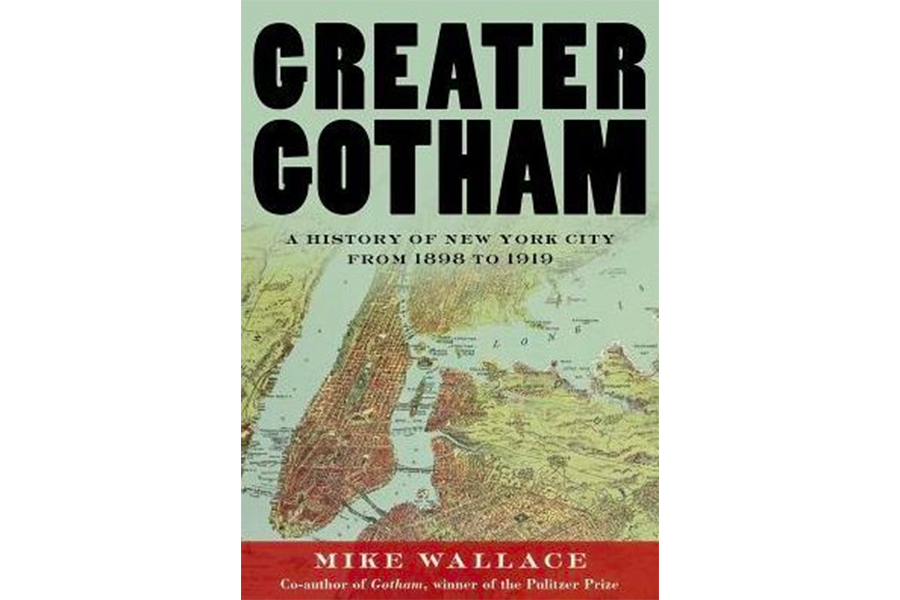'Greater Gotham' traces New York's transformation into capital of the Western world
Loading...
Mike Wallace, the author of 1998's Pulitzer Prize-winning "Gotham: A History of New York City to 1898" (co-authored with Edwin Burrows), at one point in his bracingly readable sequel, Greater Gotham: A History of New York from 1898 to 1919, quotes an 1856 issue of Harper's Monthly in which an aggravated writer scorns the very idea that New York City might ever be a beloved place. “Why should it be loved as a city?” the writer asks. “It is never the same city for a dozen years together. A man born in New York forty years ago finds nothing, absolutely nothing, of the New York he knew.”
Anyone who's ever visited the city knows that this state of permanent change continues today. New York is synonymous with the sound of building construction and demolition, and for all its famous landmarks, its most immediate visual signifier is scaffolding. Show any New Yorker a photo of a random city street and they'll be able to tell you the date of the picture based solely on what kind of scaffolding is visible. Ah, that's when they were working on the south end of St. Mark's Church-in-the-Bowery, remember how long that took?
It would be natural to think that in such a fluid state, writing a static history of any single period in the city's past would be akin to trying to grab hold of water. But in this big new book, Wallace has planted his flag in the brief span that gave rise to the modern era, a 20-year stretch that saw New York transform itself from a scruffy and hyper-energetic regional hub to a sprawling capital of the Western world.
This was a city of superlatives: the world's highest building, the world's biggest factories, the world's biggest office buildings, the world's busiest markets. In long stretches of evocative prose that serve in part to illustrate the author's own love of the place, Wallace brings this “magnificent profusion of traffic” to life in all its moving parts, showing readers the chaos of moving up the Narrows into the Upper Bay at the turn of the 20th century: “huge full-rigged ships, barks and brigs, sloops and coasting schooners laden with country produce; white-and-gold excursion steamboats with bands playing and flags flying; great funneled transatlantic liners belching smoke; tugs hauling long lines of canal boats or garbage scows; Standard Oil tankers loaded with kerosene; magenta-and-olive ferryboats, yachts, oil lighters, dredgers, elevator boats, oyster sloops, catboats, barges topped with railroad cars; and all this accompanied by clanging bells, shrieking whistles, snorting steam, and shouting men.”
Wallace matches all this oversized activity with a gallery of unforgettably oversized characters, like zealous “City Beautiful” campaigner Charles Lamb, who crusaded against the “skyboom” of taller and taller buildings going up all over town in the early years of the 20th century (he denounced the now-beloved Flatiron Building as a monument to developer greed and said that “architecturally, it is unfit to be in the center of the city”). Or George M. Cohan, the song-and-dance man who became “the personification of Broadway.” Or John Bigelow, the presiding genius behind the New York Public Library, which was officially dedicated in May of 1911 with President Taft in attendance. Thousands of builders and strivers and shirkers and connivers hustle through Wallace's pages, some pausing for only a paragraph, others staying for a few pages. The effect of all this as a reading experience is uncannily akin to living in a big, buzzing city.
There are the predictable heartbreaks as well – in a city where the jackhammers never sleep, it could scarcely be otherwise. Buildings, streets, and whole neighborhoods appear in the narrative, flourish and for a time seem eternal, and then get unsentimentally bulldozed. Wallace is suitably awed, for instance, by the construction of “another of the age's circulatory marvels,” Grand Central Terminal, but readers of a certain age won't be able to see such descriptions without reflecting on the sorry fate Grand Central's eclipsed rival, Penn Station, would meet in 1963.
Wallace covers everything in this immense and compulsively readable volume: art, architecture, music, politics, finance, theater, civil rights, and, as this part of his story winds down, the odd effects of World War I on the city. The resulting mosaic is as loud and boisterous as the city it describes, a city pushing and lunging and rushing into a new century it fully intended to dominate.
And as much of a banquet as "Greater Gotham" is for its readers, it also serves as a floated hope, the implicit invitation to Wallace, the invitation we give to all our best storytellers: keep going. New York in the Roaring Twenties and the Great Depression? Everyone finishing "Greater Gotham" will want to know what Wallace could make of all that. And New York in the '40s and '50s? "Greatest Gotham," anyone?






